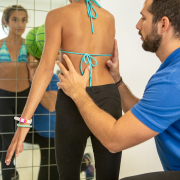Are bracing and exercises really still the only way to “solve” the problem?
This is a question many parents ask us when scoliosis is diagnosed. Perhaps their child has a particularly tricky curve, or maybe they themselves can remember dealing with the same condition when they were young. It is the same question we were recently asked by the mother of a five-year-old girl who, at this tender age, already has to reckon with a challenging treatment, “trapped” in a brace.
Unfortunately, despite huge strides made in the formulation of less invasive and more effective braces (such as the Sforzesco type that we at ISICO, have long used as a valid substitute for plaster casts), bracing and specific exercises remain the only conservative treatments available for scoliosis.
No parent wants their child to suffer the same negative experiences that they themselves remember, and it is perfectly understandable to be concerned about the possibility of them living the “nightmares” we did, and to want to protect them as far as possible. On the other hand, if this is something you have gone through yourself, you will actually be ideally placed to really understand all the difficulties your child is likely to face, and to help them find the best way to cope. It is not being complaining to ask whether other options exist and whether your child really does have to wear that uncomfortable piece of plastic — these are, after all, questions that any parent would ask.
So, to return to the question, are there any other effective and less difficult treatments? Unfortunately, as explained in a recent study, manipulation and osteopathy, like all manual treatments, have not yet been shown to be effective (https://www.ncbi.nlm.nih.gov/pmc/articles/PMC9833903/).
Given the questions we so often get asked, we feel it is essential to properly explain the reason for certain aspects of the treatment, such as the need to ensure that brace-off hours are consecutive, the importance of performing specific exercises, and the duration and dosing of the treatment.
When deciding how long the treatment will last and how aggressive it needs to be in terms of the dose (i.e., number of brace-on hours per day), the factor we consider is the potential risk of the condition worsening. This risk is assessed based on the extent of the scoliotic curve and how much growing the patient still has to do (residual growth). Scoliosis worsens with growth, therefore the earlier it arises, the more likely it is to get worse, especially during growth spurts, when the youngster gains height rapidly (these usually happen at 6/7 years of age and in puberty).
Based on this information, the treatment can be adjusted, reducing or increasing the dosage according to the period of risk.
It also follows that the earlier scoliosis arises, the longer the treatment will need to be, given that bone growth has to be complete to reach a stable situation. Then there is the question of the “brace-on” hours. It has been demonstrated that after putting on a brace, it takes at least two hours for the spine to achieve the desired correction.
This means that, when the brace is repeatedly taken off and put back on, we have to consider, and count, not only the brace-off hours, but also the hours needed for the spine to return to its correct position inside the brace. In the same way, every time the brace is removed the back tends to spring back to its starting condition (rather like a spring that has been pulled and then reverts to its original shape).
Then, the more frequently the brace is taken off to give the patient a break, the less effective the treatment will be compared with wearing it for the same number of hours but with fewer and longer breaks. For this reason, it is essential to try and establish and maintain a regular brace-wearing schedule.
We know that bracing treatment is very challenging and also that managing the brace-off hours can be difficult, especially during the summer. For this reason, we advise families, as far as possible, to choose somewhere cooler for their holidays, and also to talk to their specialist to see whether, on some days during the summer, the brace-on hours can be reduced or the brace-off time can be split into two blocks. Obviously, these decisions have to be taken on a case-by-case basis.
As for the specific exercises for scoliosis, these are designed to help support the back when the brace is not being worn, and also to prevent loss of muscle tone (otherwise an inevitable consequence of bracing). In the case of very young children (like the little girl whose mother prompted us to write this post), we recommend lots of sport to keep the muscles in shape, because children aged 4 to 6 years often don’t yet have the concentration necessary to be able to cope with exercise sessions.
Finally, in answer to the question, yes, at present, bracing and exercises are the only conservative therapy options that have been shown to work. This kind of treatment is certainly difficult and demanding, but we have to remember that it aims to help our children reach adulthood with healthy backs, and fortunately, we do at least have these “instruments” to offer them.


